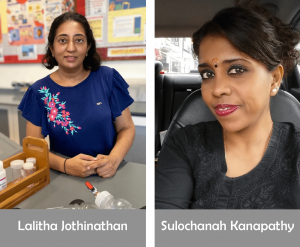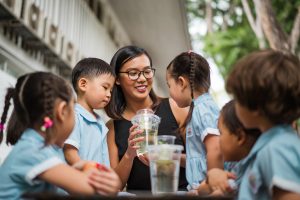Why Singapore’s English Teachers Should Embrace Singlish, Not Fight It
Is it time for Singaporean educators to embrace Singlish as a legitimate learning tool? What the Research […]
Read More
A distinctive feature of a knowledge building classroom is an environment where both teachers and students actively participate in creating and building on knowledge. Teachers take on the role of a facilitator who advances the inquiry process by supporting team collaboration while students take ownership of their own learning. Two teachers, Ms Lalitha Jothinathan and Ms Sulochanah Kanapathy, share with us their experiences in practising Knowledge Building in their classrooms.

Reflecting on her knowledge building (KB) journey since 2013, Lalitha Jothinathan, a Science teacher from Broadrick Secondary School, shares how she got her start on KB.
“I wanted to explore more ways on how I can progress towards student-centred learning and at the same time, expand my teaching and learning pedagogical toolkit. An important change that I have observed over the years is that students no longer passively receive content from teachers. Instead, both teachers and students generate and explore ideas together as a learning community.”
Preschool teacher Sulochanah Kanapathy began her journey with KB two years ago when Ramakrishna Mission Sarada Kindergarten started working with NIE researcher Dr Teo Chew Lee on a KB pilot project. She describes how she had to adapt herself to a new teaching approach that moves students toward a higher level of agency.
“In early childhood education, preschool teachers usually use the ‘K-W-L’ strategy, which stands for ‘What I Know’, ‘What I Want to Know’ and ‘What I Learned’, as a way to guide and organize their learning. The outcome is clear and defined. However, with KB, I had to adopt a change in mindset as the way the lesson advances depends very much on the ideas and questions that each child generates,” she shares.
“Using real-world issues to anchor deeper understanding of a topic helps in surfacing to these young people how the knowledge, skills and values, ethics and attitudes that they are learning in school and beyond can impact life and society.”
– Lalitha, on the benefits of linking real-world issues to what students are learning
One of the key principles of KB involves engaging students in discussing authentic problems, a practice implemented in Lalitha’s and Sulo’s classrooms. For example, when learning about the topic of cells, Lalitha guides her students to explore ideas on molecular genetics as well.
She observes that as they continuously work on improving and expanding their ideas, the topic can diverge into values and ethics of genetically modified organisms. The synthetization of ideas has also led to de-silo learning where they could see links between different topics.
“Using real-world issues to anchor deeper understanding of a topic helps in surfacing to these young people how the knowledge, skills and values, ethics and attitudes that they are learning in school and beyond can impact life and society,” Lalitha shares.
Learning and understanding real-world issues can start as early as the preschool years too. For two hours each week, Sulo conducts project-based lessons that allow her students to discuss and share their ideas on solving problems such as food and plastic waste.
To encourage them to think of creative and diverse ideas on their own during class discussions, she conceptualized a simple reward system. “Each time one of them contributes a different idea related to the topic, I will draw connecting lines, together with his or her name, on the board. Being self-centric 6–year–olds, they are eager to see their names and lines on the board and will put in effort to improve on their ideas.”
She also notes that bringing them on excursions such as to food banks, where they can learn about the shelf life of foods, and hawker centres, where they can do hands-on research on food wastage, are a good way to surface earlier discussions.
Knowledge Forum (KF) is an online platform that is specifically designed to support KB inquiry. “Aside from classroom activities, the students also learn through using KF. As the diverse ideas multiply and expand, we are able to visualize the process of a single note expanding into a web of ideas through this online platform,” Lalitha explains.
She shares that students use scaffolds provided in the KF such as “I need to understand…”, “My theory/idea is…”, and “New information/source…” as a way to reflect on their thinking process. Based on their responses shared on KF as well as KF’s analytical tools, Lalitha is able to track the progress of each student and the class.
Sulo’s kindergarten, meanwhile, has put in place a “project journal” for each child as they progress in the KB class. The journal showcases each child’s work including the group discussions they have been involved in.
“We also evaluate their dispositions and level of cooperative play during KB as part of their holistic yearly assessment. In many ways, KB has been integrated into the curriculum,” she says.
“We also evaluate their dispositions and level of cooperative play during KB as part of their holistic yearly assessment. In many ways, KB has been integrated into the curriculum.”
– Sulo, on the integration of KB into the curriculum
Integrating KB into her Biology lessons has given Lalitha a better understanding of how her students think and learn. She is able to explicitly discuss with them on their learning and motivate them to develop an interest in Biology. From their feedback, Lalitha says that her students are able to understand Biology as more than just a school subject.
“It is important to emphasize to our students that learning is a life-long process. I hope that more teachers have the opportunity to use tenets of KB as one of their pedagogical tools that they can use to shift towards an idea-centred collaborative learning,” she adds.
Similarly, Sulo hopes that KB can be recognized as a pedagogical tool that preschool teachers can tap on in the classroom. Beyond that, she also hopes for a continuity of KB in primary school classrooms.
“The preschool environment gives the children time and space to express themselves and that should continue in primary schools as well. We should set our children up to become life-long learners and help them grow as good citizens,” she says.
